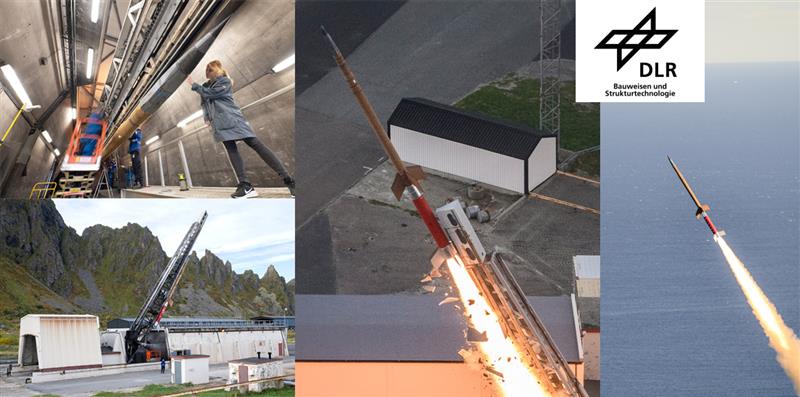DLR’s ATHEAt Rocket Flight Demonstrates CMC Nose and Movable Body Flaps
BY Composights
Published: 30 Oct 2025
The ATHEAt flight experiment, launched on 6 October 2025
from Norway s And ya Space launch site, marks a major leap in hypersonic reusable-vehicle components. Powered by the RED
KITE first propulsion stage, the mission hit speeds in excess of Mach 9 and
subjected structural materials to gas temperatures surpassing 2,000 C. Central
to the test were high-temperature composite modules specifically, fibre-reinforced ceramic nose-cones and
movable flaps engineered by the German Aerospace Center (DLR) to survive the rigours of re-entry
and pave the way for truly reusable space-transport systems.
During the flight the research rocket reached a maximum altitude of more than 30 kilometres. Comprehensive measurement data was successfully transmitted to the DLR and And ya Space ground stations.
A Treasure Trove of Data for Technology Development
Ali G lhan, ATHEAt project manager and head of the Supersonic and Hypersonic Technologies Department at the DLR Institute of Aerodynamics and Flow Technology summarises, "With the ATHEAt flight experiment, we have succeeded in flying at high Mach numbers for much longer than in our previous projects. We have now reached a new milestone and collected unique data for further research and development." This data harvest was made possible by the more than 300 sensors installed by the DLR team into the flight experiment. Also, on board were miniaturised, non-contact sensors such as infrared cameras, laser scanners and radiation thermometers. A modular data acquisition system developed by DLR recorded the measurements and transmitted the processed data by radio to ground stations below.
Extreme Stress Test for Structures, Cooling Experiments
and Flaps
The DLR team installed the payload in the front section of
the rocket, housing the scientific experiments and the service module for
measurements, the power supply and data transmission. The shimmering grey nose
cone is largely made from a special fibre-reinforced ceramic manufactured
entirely at DLR using specially developed in-house processes. This
high-performance material not only withstands very high temperatures, but it is
also mechanically very strong and relatively lightweight. The scientific payload
onboard the ATHEAt flight included two cooling experiments, which researchers
used to investigate how the extreme high temperatures at the nose of the rocket
can be managed through active cooling.
Also new on the ATHEAt flight experiment's front body were
four movable flaps also made of DLR's fibre-reinforced
ceramic which were successfully deployed during the flight and
experienced very high temperatures. In the future, such flaps could be used to
make space transportation vehicles more controllable.
"The conditions simulated in the ATHEAt flight
experiment are comparable to those that heat protection systems on future
reusable space transport systems will have to reliably withstand during
re-entry into Earth's atmosphere," explains G lhan.
The re-entry phase, with its extreme aerodynamic and aerothermodynamic conditions, is also a crucial point of development for the space industry: "With projects like ATHEAt, we are specifically working on closing this global technology gap." To this end, DLR combines flight experiments like ATHEAt and its predecessor projects supported and continuously refined with sophisticated simulations, design processes and component testing on the ground. This approach is a core element of DLR's space research strategy and, together with its many years of expertise in the field, is recognised worldwide.

For the planning and execution of missions such as the ATHEAt flight experiment, DLR has its own dedicated facility: the Mobile Rocket Base (MORABA). The team there plans, supports, and launches suborbital sounding rockets, drawing on several decades of experience. For launches in northern Norway, DLR collaborates with the And ya Space launch site.
For ATHEAt, a newly developed two-stage configuration from MORABA was used. The first, lower propulsion stage RED KITE is a joint development from DLR and the company Bayern-Chemie. Hidden under RED KITE's fairing lies a particularly powerful solid-fuel propulsion system. The second stage uses a Canadian 'Black Brant' rocket motor. This propulsion combination is especially well suited for microgravity and hypersonic research. With the scientific payload mounted at the top, the research rocket for the ATHEAt project measured approximately 13.5 metres.
To achieve the highest possible temperatures, the research rocket flew along a specially planned, shallower trajectory, enabling it to fly at high Mach numbers for an extended period at relatively low altitudes. A newly developed DLR sensor network provided essential data to determine the precise moment of ignition for the second stage. This 'sensor cube' uses a defined starting position and measures the acceleration and rotation rates in flight to calculate the position of the rocket in space. At the end of its flight, it splashed down safely in a designated and secure area of the Norwegian Sea.









